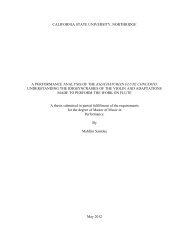Page 1 The California ""- Geographer Annual Publication of the ...
Page 1 The California ""- Geographer Annual Publication of the ...
Page 1 The California ""- Geographer Annual Publication of the ...
You also want an ePaper? Increase the reach of your titles
YUMPU automatically turns print PDFs into web optimized ePapers that Google loves.
inches. <strong>The</strong> intensity <strong>of</strong> <strong>the</strong> 1955 storm at Honeydew 2WSW can be<br />
realized when it is noted that 13.65 inches <strong>of</strong> rain fell in a 24-hour period,<br />
19.60 inches in two consecutive days, 37.60 inches in five consecutive<br />
. days, and 51.90 inches in twelve consecutive days. During <strong>the</strong> 1957-58<br />
precipitation season this station established <strong>the</strong> highest seasonal total<br />
ever recorded in <strong>California</strong> with 174.40 inches <strong>of</strong> precipitation. Table 3<br />
gives <strong>the</strong> average monthly and seasonal precipitation at Honeydew 2WSW,<br />
plus <strong>the</strong> 1957-58 monthly totals recorded at this station.<br />
<strong>The</strong> small letter "i" that Koppen usually used in conjunction with<br />
<strong>the</strong> "A" climates was found to fit a few small areas along <strong>the</strong> coast <strong>of</strong> <strong>California</strong>.<br />
<strong>The</strong> "i" as Koppen defined it meant that a region must not have an<br />
annual variation between <strong>the</strong> warmest and coldest months <strong>of</strong> over 9°F. Only<br />
three wea<strong>the</strong>r stations fall into this category (Pt. Reyes, Pt. Arena and Pt.<br />
Piedras Blancas) and only <strong>the</strong> latter two are in use at present.9 Table 4<br />
gives <strong>the</strong> mean monthly temperatures for Point Piedras Blancas.<br />
Mean Monthly Temperatures for Point Piedras Blancas (in F. 0)<br />
(based on 1931 through 1952 period)<br />
<strong>Annual</strong><br />
Jan. Feb. Mar. Apr. May June July Aug. Sept. Oct. Nov. Dec. Range<br />
51.1 51.0 51.5 51.6 52.7 54.6 55.9 55.8 56.8 55.8 55.1 53.0 5.8<br />
Tt�ble 4<br />
O<strong>the</strong>r stations such as Eureka and Point Arguello U.S.C.G. came<br />
very close to being in this classification, but did not quite qualify. However,<br />
it was felt that certain adjacent areas to <strong>the</strong>se borderline cases should<br />
be included as Csbni on Figure 1. <strong>The</strong> immediate coast line in <strong>the</strong><br />
normally foggier areas, from <strong>the</strong> Oregon border to a point west <strong>of</strong> Santa<br />
Barbara, probably experiences this same type <strong>of</strong> climate. However, this<br />
strip <strong>of</strong> coast line would be so narrow that <strong>the</strong> width <strong>of</strong> a pencil line on a<br />
map <strong>of</strong> <strong>the</strong> scale used here would completely overlay it. .<br />
Koppen's sub-symbol "c" was found to cover a considerable area in<br />
<strong>California</strong>'s higher altitudes. In this case it is associated with <strong>the</strong> D climates.<br />
<strong>The</strong> majority <strong>of</strong> this Dsc region is found in <strong>the</strong> Sierra Nevada Mountains<br />
and is a transition zone between <strong>the</strong> EH (Highland) climates <strong>of</strong> <strong>the</strong><br />
very high altitudes and <strong>the</strong> Dsb (micro<strong>the</strong>rmal with cool dry summer) at<br />
lower elevations. Only four reporting stations are actually in this type climate.<br />
<strong>The</strong>y are, from south to north: White Mountain #1 - 10,150 feet,<br />
Ellery Lake - 9,600 feet, Twin Lakes - 7,829 feet, and <strong>the</strong> station only recently<br />
established (1958) by <strong>the</strong> <strong>California</strong> Department <strong>of</strong> Water Resources<br />
at <strong>the</strong> Mount Shasta Slci Bowl - 8,500 feet in elevation. Table 5<br />
gives <strong>the</strong> average monthly temperatures for Twin Lakes and Ellery Lake.<br />
9 A climatic station that was established by <strong>the</strong> Earth Sciences Division, U.S.<br />
Army Natick Laboratories, Natick, Mass. (for a climatic study <strong>of</strong> nearby Hunter<br />
Liggett Military Reservation) at Lucia Willow Springs (between Lucia and Pt.<br />
Piedras Blancas on <strong>the</strong> Central <strong>California</strong> Coast) in 1963 also has shown temperature<br />
data that places it in <strong>the</strong> Csbni classification. ·<br />
7













